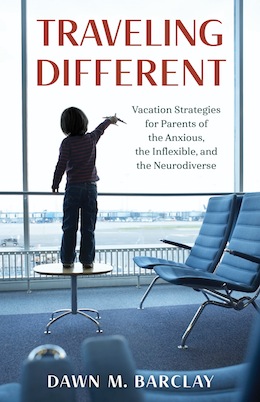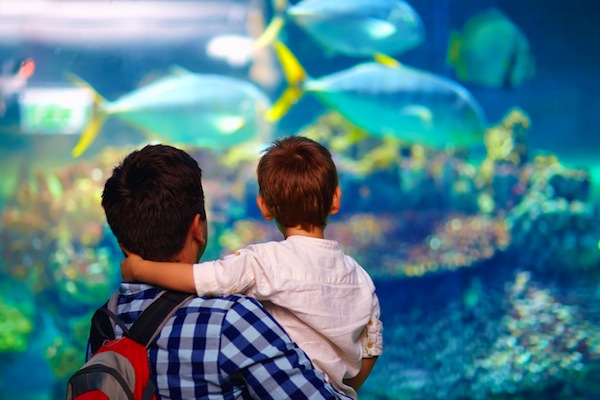One of the ways to prepare a child for a vacation is to start small. For example, take them to a local aquarium or other nearby attraction to get them used to the idea of touring. (photo from Dawn M. Barclay)
Planning a successful vacation when you have a child with ASD, ADHD, bipolar disorder and similar issues takes time, patience and practise but, in the end, you can build good memories that will last a lifetime. More great news: these tips can work for neurotypical families as well.
Here are the basics:
Understand the challenge. All children crave routine and predictability; it’s their comfort zone. Travel draws them out of their zone and into the realm of the unfamiliar, leaving even neurotypical children anxious and inflexible. Your goal is to help the child preview aspects of the vacation long before the vacation begins, in order to establish expectations of a new routine with elements now made familiar.
 Start small. Introduce the concept of travel by reading children picture books featuring their favourite characters in travel situations. (Your local librarian can recommend some.) Role-play various travel scenarios, such as going through airport security or hotel check-in. Programs like Wings for Autism can provide a dress rehearsal before the main event. Watch videos on YouTube or those provided by the travel supplier that show each aspect of the vacation, including the hotel. Consider creating a social story about each aspect of the trip and review it with the child regularly. And try “mini experiences” like an overnight stay at a relative’s house before a hotel stay, or “tours” to local zoos, aquariums or even a flea market – now relabeled as a scavenger hunt.
Start small. Introduce the concept of travel by reading children picture books featuring their favourite characters in travel situations. (Your local librarian can recommend some.) Role-play various travel scenarios, such as going through airport security or hotel check-in. Programs like Wings for Autism can provide a dress rehearsal before the main event. Watch videos on YouTube or those provided by the travel supplier that show each aspect of the vacation, including the hotel. Consider creating a social story about each aspect of the trip and review it with the child regularly. And try “mini experiences” like an overnight stay at a relative’s house before a hotel stay, or “tours” to local zoos, aquariums or even a flea market – now relabeled as a scavenger hunt.
Get buy-in. Another way to create predictability is to give the child some say in aspects of the trip. Discuss potential autism-friendly or autism-certified hotels, resorts, theme parks and other venues with a professional who has done the research for you, such as a certified autism travel professional. Then present a few parent-approved vacation options to the child and ask them to choose. You can do the same for daily activities as you prepare your itinerary (either written or in picture form). That gives you a new “routine” the child can anticipate, one where they have a personal stake in its success. Also allow the child to choose some of the clothing they’ll bring and let them help you pack. Make them active participants in their own holiday.
Make it child-centric. Traveling with youngsters, be they neurotypical or neurodiverse, can never match the pace you set when traveling before they arrived. It’s no holiday for you if you’re lugging an exhausted child on your back through a theme park. Instead of trying to cram four or five stops into your itinerary each day, plan for one or two. Try to make some of those stops extra-special by feeding into the child’s unique interests. There are specialized museums around the country for lovers of trains, insects, dinosaurs, or whatever their passion. Then set aside the afternoon to decompress at the pool or in front of the television.
Weed out potentially upsetting stimuli. Many children on the autism spectrum have sensory issues. Try to anticipate potential overload and introduce some of the unique sensory experiences in advance. For example, if you live in warmer climes and you’re heading somewhere like Alaska, practise wearing heavier and layered clothing. Or, if your child hasn’t experienced a beach, buy some sand at a crafts store, lay out a tarp and let the child feel the sensation of walking on sand before leaving on your trip.
Pack a “go-to bag.” Pack a customized bag containing the child’s favourite toys, snacks, a change of clothes and a trash bag (for any soiled ones), anti-nausea medication, noise-canceling headphones, surprises in gift bags (think Silly Putty, pens, an Etch-a-Sketch), and a preloaded iPad with kid-friendly shows and games. Keep your bag accessible and dole out the surprises to provide distractions if overwhelm sets in or plans go awry.
Remember, kids are kids. Any child can grow bored, weary and have a meltdown. Parents who think ahead, prepare their child for the new experience and are equipped to alleviate any anxiety, will be able to smooth the way while traveling.
Dawn M. Barclay is an award-winning author who has spent a career working in various aspects of the travel industry. She started as an agent with her parents’ firms, Barclay Travel Ltd. and Barclay International Group Short-Term Apartment Rentals, and then branched out into travel trade reporting with senior or contributing editor positions at Travel Agent Magazine, Travel Life, Travel Market Report and, most recently, Insider Travel Report. Her new book is Traveling Different: Vacation Strategies for Parents of the Anxious, the Inflexible and the Neurodiverse (Rowman & Littlefield Publishers, 2022). Learn more at travelingdifferent.com.

